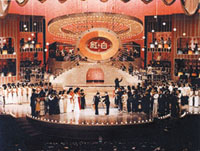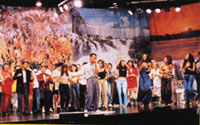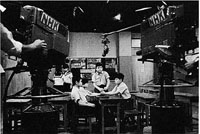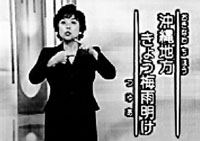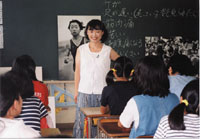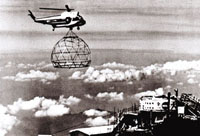
| The latest digital technologies have greatly expanded the capabilities of television, but there are limits to how much TV people can watch each day. This raises the question of what kind of content ought to be presented. NHK's aim is to offer news and programs that really count in the lives of its viewers. |
78 years of radio, 50 years of TV |
| The 2002 FIFA World
Cup The 2002 FIFA World Cup co-hosted by Japan and South Korea was an opportunity to experiment with multimedia broadcasting suited to the 21st century. Viewers of digital Hi-Vision (HDTV) were deeply impressed by its quality, and immediately recognized the tremendous potential of this kind of TV. Data broadcasts, meanwhile, used a computer-graphic environment to provide key statistics in real time: the number of passes made in each match, the ratio of successful passes, goals, fouls and many other details. Information via the Internet and mobile phones rounded off the first example of comprehensive multimedia broadcasting in the digital age. View from space In 1998, NHK succeeded in videotaping the earth for the very first time in Hi-Vision, working in cooperation with NASDA, the National Space Development Agency, and NASA in the United States. A live broadcast from space using the Hi-Vision system is also planned for the near future. Dialogue between civilizations and generations Project X: Challengers, which started in 2000, turned the spotlight on the many nameless heroes of Japan's economic and social development. NHK will continue to produce programs that give people fresh hope and enthusiasm. The world is beset by challenges that require global solutions, including many issues concerning the environment, disease, famine, food production and international security. The terror attacks of 9/11 have made the world more confusing than ever, and it has never been more important for people and nations to discuss complex matters. NHK is developing ideas and projects that will contribute to this dialogue through the medium of television. Another challenge for NHK concerns television's influence on child development. What kinds of program are most appropriate for today's children? How can TV best serve their requirements in the digital age? Answering these questions with TV programs is a top-priority issue that NHK is tackling in consultation with experts around the world. Broadcasting is an important element of culture that both directly and indirectly influences perception, thought and lifestyle. In this sense, it is rightly said that every TV service represents the true face of its country. NHK remains determined to present valuable programs that Japan can be proud of. Tracing the 50-year history of TV broadcasting has itself been a process of self-examination. Keeping in mind both that history, and 78 years of radio broadcasting, NHK will keep broadcasting news and other programs that viewers both want, and need, to see.
|
|

